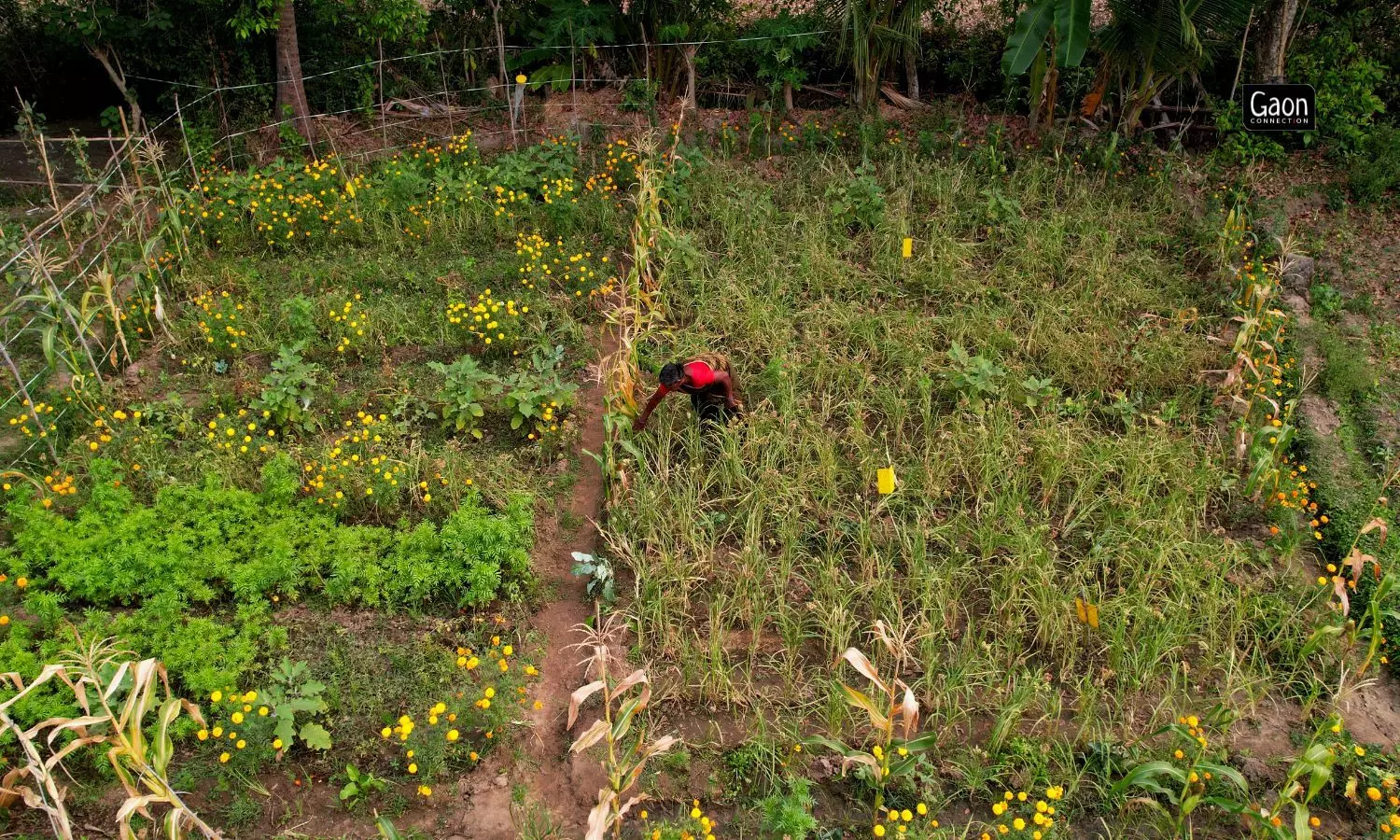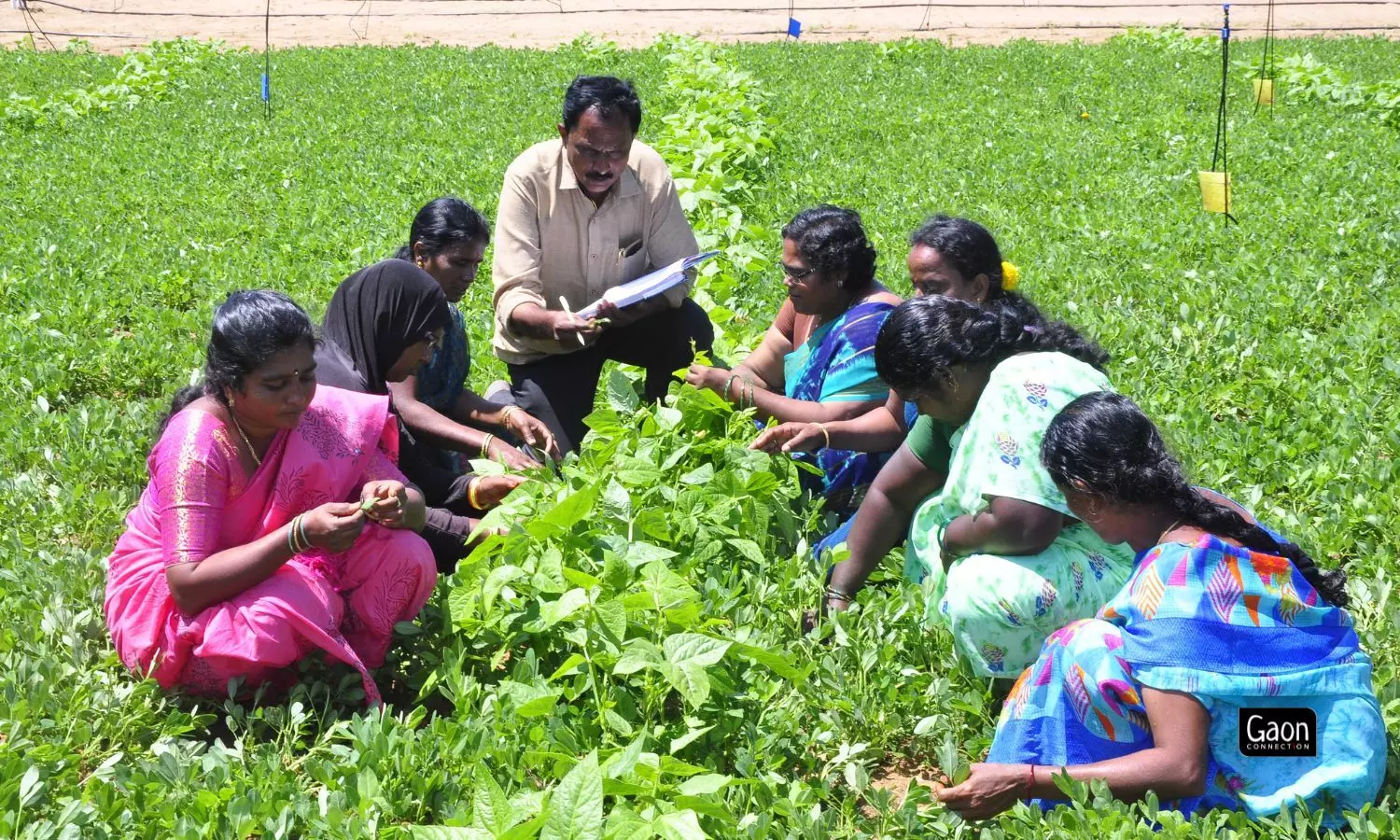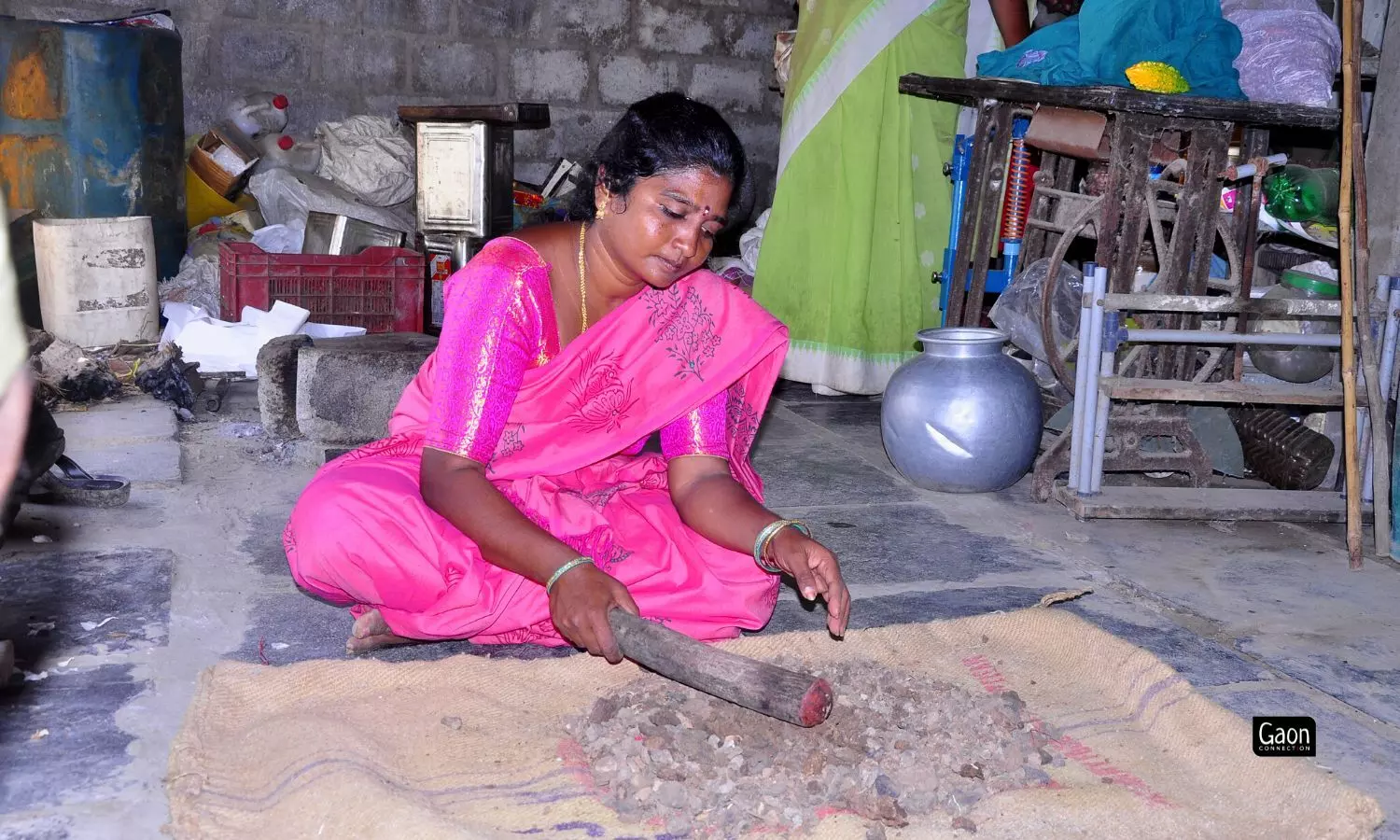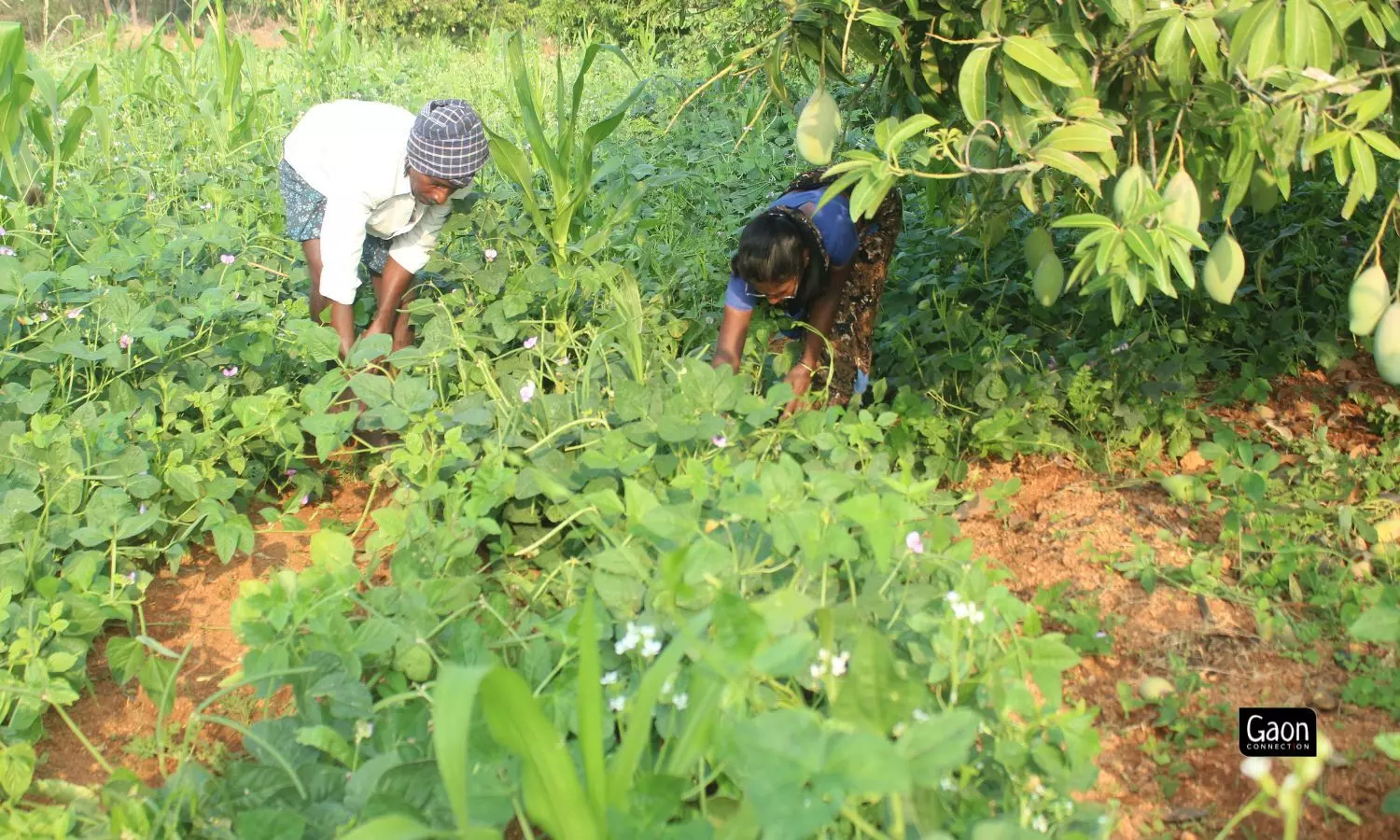P Jhansi owns one-fourth of a hectare of farmland in Gadepalam village in Andhra Pradesh. But on that small patch of land, she grows 20 crops in a year. Bengal gram, mustard, sunflower, sorghum, coriander seeds, fodder crops — name the crop and the 35-year-old farmer has tried cultivating it in her farm.
And what is even more inspiring is the fact that she grows multiple crops through natural farming without using any chemicals in her field.
“I don’t spend anything on fertilisers, pesticides and seeds now. I only use a mixture of cow dung, jaggery, and some other natural items,” Jhansi told Gaon Connection.
But it wasn’t so always. Till 2017, the farmer from Prakasam district in south India grew only red gram in kharif (monsoon) season and Bengal gram in rabi (winter), and spent about Rs 40,000 on fertilisers, weedicides and pesticides.

Andhra Pradesh Community Managed Natural Farming, which is zero budget farming, is one of the largest natural farming programmes in India.
She barely made any profit from the eight quintals (1 quintal = 100 kgs) of her produce a season she sold, and was in constant debt with the middleman from whom she bought seeds and fertilisers and also sold her produce to.
Help came in the form of a natural farming initiative that began in Andhra Pradesh in 2016 and has seen sweeping changes in the agrarian scene of the southern state.
Andhra Pradesh Community Managed Natural Farming (popularly known as APCNF) is a project of the state’s agriculture department and is being overseen by Rythu Sadhikara Samstha (RySS), a non-profit that has been set up to ensure smooth implementation of this large scale initiative.
Andhra Pradesh Community Managed Natural Farming, which is zero budget farming, is one of the largest natural farming programmes in India, and Jhansi of Gadepalam village is one of the thousands of beneficiary farmers who are a part of this movement to promote natural farming.
In 2016, when the initiative was launched, there were 40,000 farmers in 700 villages of the state who had signed up for natural farming. Today, there are 850,000 farmers in 3,730 villages who are members of this project. This accounts for 14 per cent of the state’s farmers in 27 per cent of the villages farming over 6.3 per cent area of land in Andhra Pradesh, as per the official data shared under the programme.
Directly or indirectly, the programme has impacted about 1.2 million people in the state, claims the official data.
“APCNF has created champion farmers like Jhansi who practise natural farming. Sixty per cent of the champion farmers are women,” Vijay Kumar Thallam, a retired IAS officer and now vice president of the non profit RySS, told Gaon Connection.
So far this year, Jhansi has already harvested Bengal gram, mustard and sunflower, coriander seeds and Sorghum, besides fodder crops.
Today she is a champion farmer and a resource person, who educates other farmers about natural farmers and helps them make the transition.
Like Jhansi, H. Narayanappa is another champion farmer who has adopted natural farming and is helping propagate it. The 48-year-old farmer’s Malappuram village in Anantapur district, has a semi-arid climate and no water gets absorbed in soil.

A recent study on Andhra’s natural farming initiative found that farmers who adopted natural farming had an average 11 per cent increase in yield.
“For 20 years, I only grew groundnuts in my four acres of land. The cost of cultivation kept going up and I had to take up farm labour in order to make ends meet,” Narayanappa told Gaon Connection.
In 2018, Narayanappa switched completely to natural farming and became a pioneering farmer to experiment with 365-days cropping in his region. He converted a part of his land into a mango orchard and inter-cropped it with groundnut, pearl millet, cow peas, red gram, castor, and field beans.
According to him, his groundnut yield went up from eight quintals to 12 quintals, and he also earns from other crops and vegetables now.
Also Read: Earthworms Give Techie A 20 Million-Rupee Turnover Annually
Nuts and Bolts of Natural Farming
Andhra Pradesh Community Managed Natural Farming’s model of natural farming dictates that there should be at least 15 to 20 crops on the field including trees throughout the year. There should be minimal tillage, and indigenous seeds should be used. Animals should be used for farming purposes, and biostimulants (cow-dung based inoculations) should be used to trigger soil biology.
Further, pest management should be through better agronomical practices and biopesticides. And there should be strictly no use of synthetic fertilisers, pesticides, weedicides and herbicides.
Andhra Pradesh Community Managed Natural Farming has its roots in the severe drought years in the state between 2014 and 2016. At that time, IAS officer Thallam was the Special Chief Secretary with the Department of Agriculture and Cooperation in 2015-16. He decided to do a pilot project to see how best to tackle the drought sustainably.

“I don’t spend anything on fertilisers, pesticides and seeds now. I only use a mixture of cow dung, jaggery, and some other natural items, said Jhansi
“No incentives were offered to the farmers, yet they decided to try zero budget natural farming. In the first year itself, yields were good, and that helped me silence a lot of people in the government who were inclined towards conventional farming,” Thallam narrated.
In 2018-19, farmers working with RySS reported that crops using natural farming methods required less water and could withstand dry spells up to 30 days, unlike conventional farming that used chemical fertilisers and so on.
“Research shows that crops harness water from the air and our farmers were already seeing this in their fields,” said Thallam with a sense of pride.
Also Read: Study Finds Natural Farming To Be More Profitable Than Modern Farming Practices
Pre-monsoon dry sowing
This led to the birth of a new concept — pre-monsoon dry sowing. In March-April, when the rabi crop is being harvested, 15-20 varieties of pulses, millets and oilseeds are pelletised with wood ash and other inoculants and spread out in the fields.
“The coating pellet protects the seed, allows for moisture retention and favorable conditions for seed germination. Mulch is spread across the field, which acts as the catalyst to harness the water vapour from the atmosphere that drops to the land surface in the form of early morning dew,” V Lakshma Naik, RySS’s district project manager at Ananthapuramu and Sri Sathya Sai districts told Gaon Connection. It is Naik who designed the pre-monsoon dry sowing.
“Weeds occur when there is a gap between cropping. The year-long green cover reduces evaporation losses and water run-off. Combined with crop residue mulch, it increases soil porosity and the soil’s water holding capacity also goes up,” Naik explained to Gaon Connection.
A recent study on Andhra’s natural farming initiative found that farmers who adopted natural farming had an average 11 per cent increase in yield, 44 per cent lower input costs, and 99 per cent increase in net income per hectare.

Earlier this year, Andhra Pradesh Community Managed Natural Farming introduced another farming initiative, the ATM (Any Time Money) for farmers.
“This defies the misconception that natural farming cannot feed the world. APCNF is creating four kinds of capital — knowledge, nature, human, and social — which most economists focussing on private profits miss out on,” said Pawan Sukhdev, lead author of the study published in July this year.
Alternative farming techniques like the zero budget natural farming that Jhansi and Narayanappa have adopted become important, not just for their own sustenance, but also for the climate and the larger society as well.
“Zero budget natural farming mimics nature, moving from an input intensive farming system to a biodiversity intensive one. If we stop choking nature, recovery is quick,” Sukhdev pointed out.
Earlier this year, Andhra Pradesh Community Managed Natural Farming introduced another farming initiative, the ATM (Any Time Money) for farmers.
The ATM model encourages relay cropping of a variety of vegetables that can be harvested at different times. This way the farmers start earning an income within the first fortnight of sowing and have a consistent income every month.
Narayanappa from Mallapuram village in Anantapur district is a pioneer in the ATM model. He grew radish, cluster beans, beetroot, carrot, tomato and leafy vegetables in half an acre of land.
“I earned about two lakh rupees by selling the harvest in Kalyandurgam, our local market,” Narayanappa told Gaon Connection.
In May this year, the principal secretary of the Rural Development Department visited Narayanappa’s farm and called it “the best model for rural livelihoods”.
Spreading the word
Andhra Pradesh Community Managed Natural Farming is supporting Rajasthan, Chhattisgarh and Meghalaya state governments to help them shift to natural farming. It plans to begin work with six other states too. Nepal, Rwanda and Sri Lanka have also approached for help.
In July this year, Andhra Pradesh Community Managed Natural Farming launched a ‘Farmer Scientist Programme’ that will provide a four-year B.Sc in natural farming.
According to Thallam, 77 per cent of their expenditure is on training the master farmers. The goal of the state-level natural farming programme is to reach 85 per cent of the farmers in the state in the next seven years.



















